 |
| The Canon 6D. |
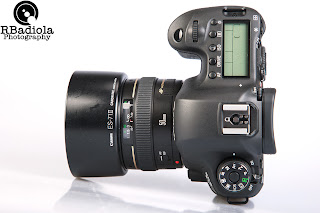 |
| Canon 6D top. The mode dial now has a lock button. |
 |
| The ports are minimized, no more pc port and the a/v out and usb are now combined. |
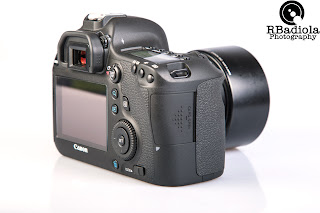 |
| Canon has now decided to use an SD format for this FF camera. |
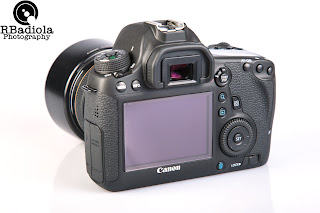 |
| No Joystick controller for this body. Canon has combined it with the control wheel. |
 |
| Compared to the 5D MK2 The 6D has a smaller, lighter, narrower body. |
Now here are the coolest features of the 6D.
The 6D is now equipped with a gps which is very useful for landscape photographers. It adds location information to the images so it keeps track of where the images were taken.
It has an in camera RAW to JPG processor. You can now process your images with the camera itself. It let's you adjust the brightness, size, WB, lens distortion, aberration, noise reduction, color space, peripheral illumination, picture style and auto lighting optimizer. After everything has been adjusted the image will be saved as a jpg.
In camera HDR processing - for you HDR aficionados out there, you can now process HDR files in camera, the disadvantage to the 6D is that it only does it in jpg mode, not with RAW as the 5D MK3 can do.
Wifi - this is one of the reasons that got me into this camera. You can now view your images in the camera using your smartphone via the dos remote app. Also, you can control your camera with your smart phone. The camera switches into live view and you can view what's in the viewfinder from your phone. The setup is pretty easy, it took me about 5 minutes to set everything up.
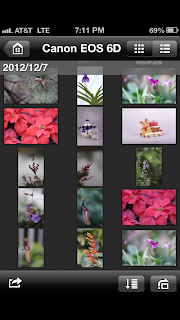 |
| You can view your images with your phone, and save them in your photos. |
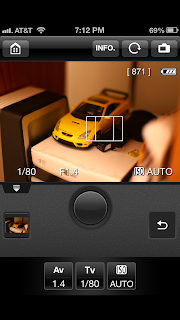 |
| Live view mode works in your smartphone. Wirelessly control the 6D. |
 |
| The Canon EOS app interface, pretty simple. |
You can also email, send to Facebook, etc. the photos in your 6D. You need an existing wifi network to connect to. You will also need a Canon image gateway account, which is free. Once you all have that, you can send the photos directly from your 6D.
As of the time of writing, my existing camera raw plugin on my mac does not support the 6D yet. I had to convert everything in camera using the built in RAW processor in the 6D. It works, although not as good as Adobe Lightroom 4. That is a disadvantage when buying a camera that has just come out days later.
I tested my 6D today and got a couple of shots. It was cloudy today do it was really hard getting color on my clouds in my shots. I had the day off so I really didn't have the choice.
These images were processed using the in camera RAW converter with basic adjustments. Again these images would have more pop if they were processed in Lightroom. As of now, the camera raw plugin doesn't support the 6d YET.
Using the 6D, I conclude that it handles pretty well. You don't get the bulk and weight from a 5D MK2 but it also doesn't feel like a toy, like a Canon Rebel XTI. It is actually one of the best feeling cameras in your hand. The controls especially the wheel/directional button takes some time to get used to, especially if you were so used in using the 5D MK2 or a 40/50D. Although at the end of the day, I got so used to it that the 5D felt strange. The shutter sounds different compared to older EOS cameras. I like it. especially when you can tone it down. The auto ISO works excellent compared to the 5D MK2, it just works the way you want it to. The wifi I admit is one of the cameras strongest selling points, for some photographers this is an unnecessary feature, but once you use it you'll be impressed.
Now on to the comparison between the 5D MK3 and the 6D. The 5D MK3 has 22.3 mp against the 6D's 20.3. Not that much difference. Even if you print out 16x20" prints, 2mp would be barely noticeable. The 5D MK3's continuos drive is 6 frames per second against the 6d's 4.5, in some cases that would make a difference, but 4.5 frames per second isn't bad for fast action shooting, it's better than the 5D MK2's 3.9 fps. I've used the 5D MK2 for birding, and anything faster than the MK2 is better. The 5D MK3's focus points are 63 compared to the 6D's 11, there are cases where this is good and bad. Sometimes you don't really need all those focus points to capture something. Sometimes more focus points are a hassle to select, but then again there are a lot of people who benefit from this. The 5D MK3 has a maximum shutter speed of 8000/sec, while the 6D has 4000/sec, but hey, how often are you gonna use that? If I was a very rich guy, I'd go for the 5D MK3. There are a ton more differences between the two, but for a thousand dollars less, I'd stick with the more basic 6D. The 5D MK3 is an excellent camera don't get me wrong, but a lot of photographers aren't gonna need the extra features that it has. If you need the extra features, go for it.
So far I have only tried the still imaging side of the 6D. Video is another thing. I'll do that some other time. For now, the still imaging side of it is more important for me.
Basically I have discussed the features of the 6D in laymen terms. I have discussed the features that you will use everyday. I'm not really gonna go to the real specifics...I'm just gonna let a review site do that for all of you.
If you need a new full frame body, or a secondary one for a backup, the Canon EOS 6D is a camera you should consider. The toned down version of the 5D MK3 doesn't seem that it's really toned down at all. It's loaded with features that a lot of photographers will find useful. I know I'll keep mine for years to come.












Tnx for the insight
ReplyDelete